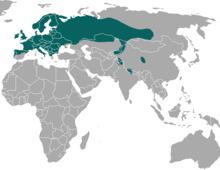You can help expand this article with text translated from the corresponding article in Italian. (June 2022) Click [show] for important translation instructions.
|
The Eurasian pygmy shrew (Sorex minutus), often known simply as the pygmy shrew, is a widespread shrew of the northern Palearctic.
| Eurasian pygmy shrew[1] Temporal range: Early
| |
|---|---|

| |
| Scientific classification | |
| Domain: | Eukaryota |
| Kingdom: | Animalia |
| Phylum: | Chordata |
| Class: | Mammalia |
| Order: | Eulipotyphla |
| Family: | Soricidae |
| Genus: | Sorex |
| Species: | S. minutus
|
| Binomial name | |
| Sorex minutus Linnaeus, 1766
| |

| |
| Eurasian pygmy shrew range | |
Description
editIt measures about 5 cm (2.0 in) in length, not including the 3.5 cm (1.4 in) tail, and has an average weight of 4 g (0.14 oz).The hair on the back is blackish with shades ranging from reddish to purplish, very dense and shiny: the belly, throat, jaw, periocular area and lower part of the tail are contrasted whitish. The muzzle and legs are covered with sparse white hair (vibrissae in the muzzle ), while the skin is flesh colored: the ears are small and half hidden by the hair, they are dark flesh colored and shaped like a semicircle. In this species the head is larger in proportion to the body than in other shrews. It may be confused with Eurasian least shrew and the Etruscan shrew.
Behaviour
editEurasian pygmy shrews are solitary animals, active throughout the day and night and inhabiting areas of dense vegetation across a broad elevation range.[3] It lives off seeds, small insects and other invertebrates.[4] They use the burrows or tunnels of other rodents to live in, alone they burrow under tree stumps.They have many predators. The whole life is spent on a few hundred square metres where they establish trackways.The Eurasian pygmy shrew has one of the highest metabolic rates of any animal; to maintain homeostasis, it must eat every two hours.[5][6] Due to this, it eats up to 125% of its body weight (about four grams) each day.[7] They are active for 24 hours per day in very short periods interspersed with sleep (say, 15 minutes of activity followed by 15 minutes of sleep).
Breeding
editThe breeding season lasts from April through to August. Females usually produce between two and eight young per litter and care for the young in an underground nest. Since the gestation period is just over three weeks, they can have up to five litters in one year, though the life span of a pygmy shrew is a little over 15 months.[4]
References
editContent in this edit is translated from the existing Italian Wikipedia article at it:Sorex minutus; see its history for attribution.
- ^ Hutterer, R. (2005). Wilson, D.E.; Reeder, D.M. (eds.). Mammal Species of the World: A Taxonomic and Geographic Reference (3rd ed.). Johns Hopkins University Press. p. 292. ISBN 978-0-8018-8221-0. OCLC 62265494.
- ^ Hutterer, R.; Kryštufek, B.; Fernandes, M. & Meinig, H. (2017) [errata version of 2016 assessment]. "Sorex minutus". IUCN Red List of Threatened Species. 2016: e.T29667A115171222. doi:10.2305/IUCN.UK.2016-3.RLTS.T29667A22316362.en. Retrieved 17 February 2022.
- ^ "Sorex minutus". Animal Diversity Web. Retrieved 2022-05-25.
- ^ a b "UK safari on Pygmy shrews". Retrieved 2007-12-27.
- ^ "Sorex minutus", Memoirs and musings from the Phibius Log, 12 July 2007
- ^ Burton, Robert; Burton, Maurice (1970). The international wildlife encyclopedia. Marshall Cavendish. pp. 2358–2359. ISBN 0-7614-7266-5. Retrieved 22 December 2010.
- ^ "Pygmy shrew". The Mammal Society. Retrieved 28 February 2022.
